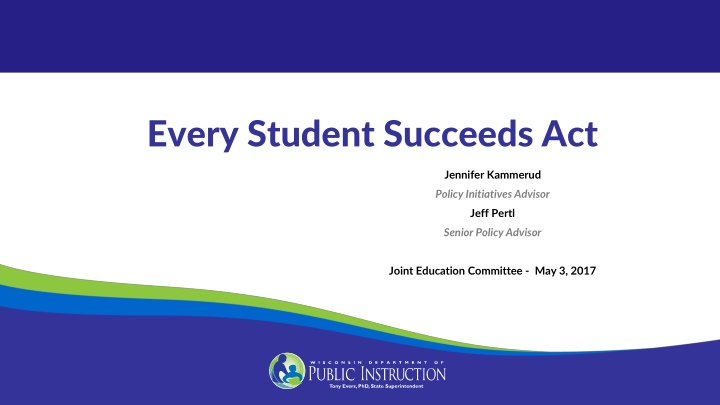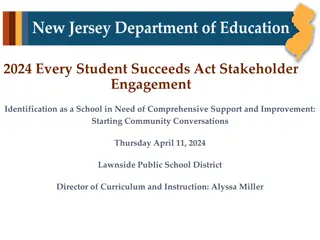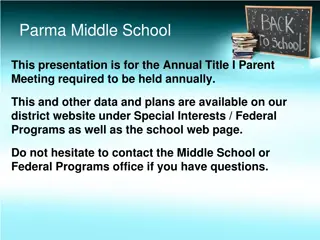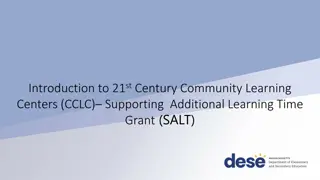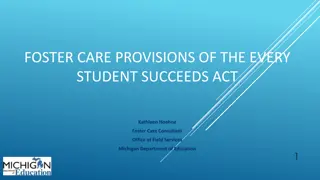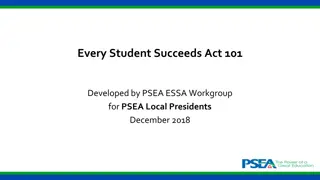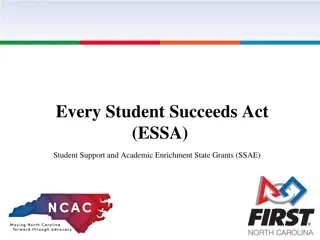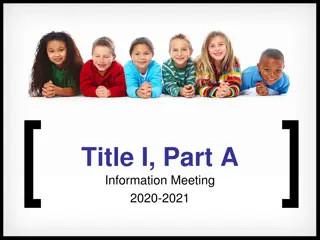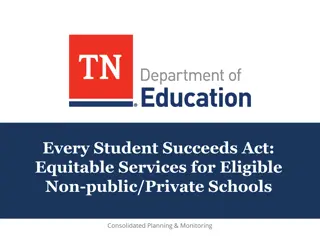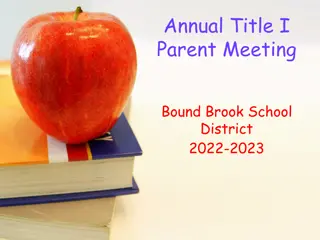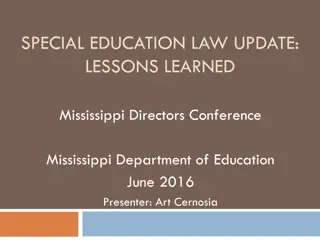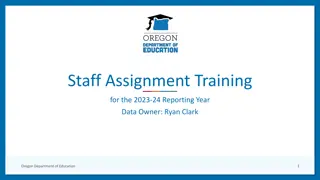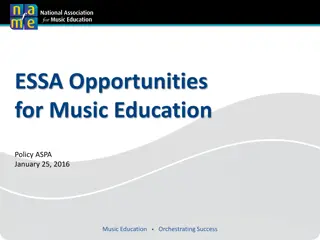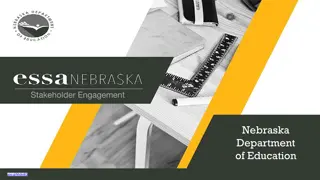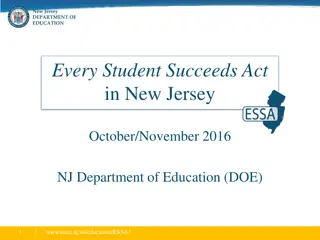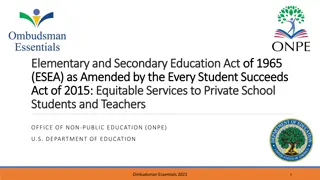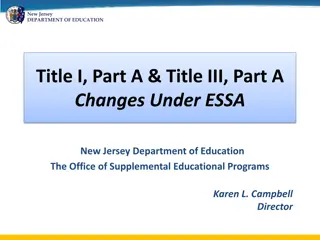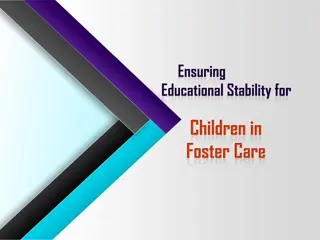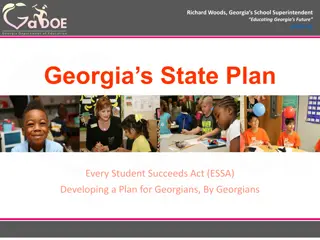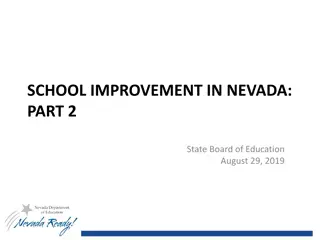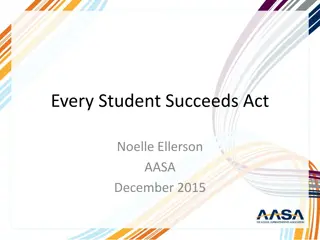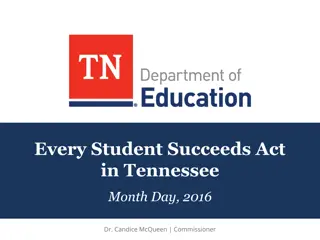Overview of Every Student Succeeds Act
The Every Student Succeeds Act (ESSA) aims to address educational accountability and improvement through locally-focused strategies. It includes core requirements and state accountability measures for schools and districts. ESSA emphasizes student achievement, growth, and postsecondary readiness, placing schools in performance categories based on accountability indicators.
Download Presentation

Please find below an Image/Link to download the presentation.
The content on the website is provided AS IS for your information and personal use only. It may not be sold, licensed, or shared on other websites without obtaining consent from the author.If you encounter any issues during the download, it is possible that the publisher has removed the file from their server.
You are allowed to download the files provided on this website for personal or commercial use, subject to the condition that they are used lawfully. All files are the property of their respective owners.
The content on the website is provided AS IS for your information and personal use only. It may not be sold, licensed, or shared on other websites without obtaining consent from the author.
E N D
Presentation Transcript
Every Student Succeeds Act Jennifer Kammerud Policy Initiatives Advisor Jeff Pertl Senior Policy Advisor Joint Education Committee - May 3, 2017
Agenda I. II. Goals III. Additional Accountability Indicator IV. School Improvement V. Educator Development VI. Student Supports VII.Next Steps Review Timeline & Process
Deadlines & Process Assurances: Due June 2, 2017 State Plan Template: Due Sept. 18, 2017 KeyTimeline Considerations: Submission Date: Sept. 18 Required minimum 30 day public review of plan. Required minimum 30 day review by Governor. DPI will revise the plan based on public, stakeholder, legislative, and gubernatorial input.
Core Requirements Many provisions pieces of the law are similar to or unchanged from No Child Left Behind Annual testing grades 3-8 and once in high school. Private schools are entitled to services allocated from school district federal funds. The state must identify schools if they aren t meeting certain benchmarks. States must look at and address the distribution of teachers. States must disaggregate test data by subgroups. Homeless student provisions continue to apply under McKinney Vento. States and schools must make available school performance information annually.
ESSA is More Locally-Focused ESSA School focused, District led NCLB District & school focused Federally-determined interventions Locally-determined interventions State monitored prescriptive requirements State is focused on implementation Priority & Focus Schools Targeted (gaps) & Comprehensive (low achievement)
State Accountability is Primary State Law Federal Law Requires a report card for public schools, school districts, and choice schools. Requires individual public school reports. Report Cards measure four priority areas: Student Achievement (English language arts, math) Student Growth (value-added, weighted relative to student poverty) Closing Gaps On-track and Postsecondary Readiness Report cards also look at performance on three student engagement Indicators: test participation, absenteeism, and dropout rate. Accountabilityindicators must include: Results of state assessments A student growth or other measure at the elementary level High school graduation rate at the high school level English language proficiency (for English learners) At least one indicator of school quality or success Report card results place schools and districts in one of five categories, identifying high-, mid-, and low-performing schools. Accountability reporting is used to identify the lowest-performing schools (comprehensive) and schools with persistent achievement gaps (targeted). Interventions outlined under state law for schools falling in the bottom category for a number of years include direction from the State Superintendent and the Opportunity Schools Partnership Program. Targeted support schools are required to develop a plan for improvement that is overseen by the school district. Comprehensive support schools are required to develop a plan for improvement that is monitored and approved by the state. Other Technical Points 1. Non-tested students don t count against the district or school. 2. State system does not require summative results at a subgroup level. 3. State system has no similar restrictions. Other Technical Points 1. Non-tested students count against the school. 2. Summative results at the subgroup level are required. 3. Requires the same data be used for schools in the same grade band.
DRAFT Long-Term Goals Input: Set Ambitious Goals Achievement gap is Wisconsin s most important challenge A decade too long for goals Proposal: Cut Achievement Gaps in Half within 6 years English Language Art proficiency Mathematics proficiency Graduation Goals by subgroup (race, disability, EL) Therefore the target goal varies by each subgroup Interim measure reported annually
III. School Quality & Success Indicator
ESSA Requires a New Data Indicator This may include these measures: student engagement Engagement educator engagement student access to and completion of advanced coursework College & Career Readiness postsecondary readiness suspension & expulsion (discipline data) Climate & Safety bullying, harassment, crime data, etc. Or . we could use chronic absenteeism, which is already collected as part of the State Report Card System.
DRAFT Indicator Input: Use existing data; Focus changes on the state report card Great interest in college and career metrics for a revised/updated state report card for high school Interest in other indicators: early childhood; parental involvement; physical education, etc. Accountability should be universal, meaningful, fair, and drive improvement Proposal: Chronic Absenteeism 1. A student is chronically absent if they miss more than 10% of possible attended days; then 2. Rate is calculated by school, using multiple years of data
School Improvement Requirements School Improvement Requirements Identification Support Targeted Support (old focus schools) Schools with consistently underperforming subgroups as defined by the state. Targeted Support Schools implement subgroup improvement plans, approved and monitored by the district. Comprehensive Support (old Priority schools) 1. 5% of lowest performing Title I schools in achievement as defined by the state. 2. All high schools with less than 67% high school graduation rate. 3. Title I Schools with underperforming subgroups that do not improve after state- determined number of years. Comprehensive Support* Districts (LEAs) develop support and improvement plans with required elements. Plans are approved and monitored by the state. *No improvement in 4 years State must take more rigorous action.
Draft Draft More Rigorous Intervention More Rigorous Intervention Input: Require Rigor, Provide Support Professional Development and Coaching Positive Behavior Interventions and Support Data Analysis Alignment, Implementation, and Collaboration Revised School Day/School Year Structure Funding and Resources Consistency Flexibility Student-focused Support teachers and administration Provide monitoring and support Proposal: Implementation & Improvement 1. Independent Implementation Review 2. Customized Improvement Plan 3. Requirements & Supports Family & Community Engagement Professional Development Mental Health, Socio-Emotional Learning, & Behavioral Issues Community Schools, Project-Based Learning, & Personalized Learning Expanded Academic Improvement
Improving Practice and Student Outcomes Input: Align educator and school improvement efforts Proposal - Focus state efforts on the following initiatives: Use of data to improve student outcomes Build and support effective school leadership Equitable access to teachers Teacher professional development Response to intervention Results driven accountability
VI. Student Supports & Other Provisions Migrant Education Neglected, Delinquent, and At-Risk Youth English Learners
Special Student Populations Special Student Populations English Learners (EL) Statewide entrance and exit criteria Supports to all schools Intensive supports to the following schools Schools identified as comprehensive or targeted supports and identified as having insufficient EL progress. Transition schools Monitor Schools At-Risk Youth Transition plans with other state agencies Technical assistance Migrant Students Systems to ensure educational continuity Statewide service delivery plan Interstate coordination
Other ESSA Requirements Other ESSA Requirements Basic Learning Grant Performance information for military and foster care students Foster care liaison School Level Financial Reporting Private School Ombudsman Equitable Participation Provisions Cap on alternate assessments for special education students Assessments provided in other languages
Listening Sessions & Feedback Listening Sessions & Feedback Stakeholder engagement is a critical part of our planning process DPI will host listening sessions and is soliciting online feedback Date Location June TBD Milwaukee June TBD Wausau/Eau Claire June TBD Up to four other locations under consideration Online public feedback being solicited now through June 30, 2017.
Equity in ESSA Council Equity in ESSA Council Darienne Driver Council for Great City Schools Brian Jackson Wisconsin Indian Education Association (WIEA) Rep. Adam Neylon Assembly Majority Michael Anton Wisconsin PTA Heather DuBois Bourenane Wisconsin Public Education Network (WPEN) John Jacobs Wisconsin eSchool Network (WEN) Sen. Luther Olsen Senate Majority John Ashley Wisconsin Association of School Boards (WASB) Tony Evers Wisconsin Department of Public Instruction (DPI) Brian Juchems Gay Straight Alliance for Safe Schools, GSAFE Rep. Sondy Pope Assembly Minority Jon Bales Wisconsin Association of School District Administrators (WASDA) Kim Kohlhaas Wisconsin Federation of Teachers (AFT- Wisconsin) Lisa Pugh Disability Rights Wisconsin (DRW) Fran Finco Wisconsin Association for Supervision and Curriculum Development (WASCD) Jim Bender School Choice Wisconsin (SCW) Sean Roberts Milwaukee Charter School Advocates (MCSA) Stephen Kolison University of Wisconsin System Jesse Harness CESA Statewide Network Evan Bradtke Wisconsin Governor s Office Jim Lynch Association of Wisconsin School Administrators (AWSA) Sen. Lena Taylor Senate Minority Mike Haynes Cooperative Educational Service Agency 10 Salvador Carranza Latino Education Council Rolf Wegenke Wisconsin Association of Independent Colleges and Universities (WAICU) Chris Her-Xiong Wisconsin Southeast Asia Resource Action Center Representative Ronald Martin Wisconsin Education Association Council (WEAC) Kathleen Cullen Wisconsin Technical College System Frank Humphrey Wisconsin NAACP, Madison Woodrow Wiedenhoeft Wisconsin Association of School Business Officials (WASBO) Ralph Hollmon Milwaukee Urban League Gary Myrah Wisconsin Council of Administrators of Special Services (WCASS)
Additional Review Additional Review July August July 28 Legislative Review Requested by DPI Version 2.0 Released Gubernatorial Review
Process and Timelines Review Process and Timelines Review KeyTimeline Considerations: Submission Date: September 18 Required minimum 30 day public review of plan. Required minimum 30 day review by Governor.
